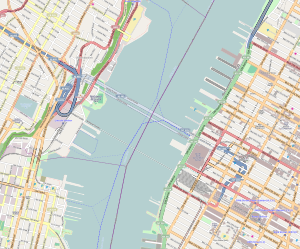Lincoln Tunnel
| Lincoln Tunnel | ||
|---|---|---|
|
East portal of middle tube and south tube in Manhattan
|
||
| use | Road tunnel | |
| place |
Weehawken New York City |
|
| length | 2504 m | |
| vehicles per day | 108,655 (2011) | |
| Number of tubes | 3 | |
| construction | ||
| building-costs | US $ 85,000,000 (approx. US $ 1,458,743,781 today) | |
| start of building | • 1934 (middle tube) • 1937 (north tube) • 1954 (south tube) |
|
| completion | • 1937 (middle tube) • 1945 (north tube) • 1957 (south tube) |
|
| business | ||
| operator |
Port Authority of New York and New Jersey |
|
| toll | up to $ 15 | |
| release |
• December 22, 1937 (middle tube) • February 1, 1945 (north tube) • May 25, 1957 (south tube) |
|
| map | ||
 Course of the tunnel under the Hudson River
|
||
| location | ||
|
|
||
| Coordinates | ||
| Weehawken West Portal | 40 ° 45 ′ 59 " N , 74 ° 1 ′ 22" W. | |
| East Portal Manhattan | 40 ° 45 ′ 26 " N , 73 ° 59 ′ 48" W. | |
The Lincoln Tunnel (US spelling "Lincoln Tunnel") is a 2.5 kilometer long road tunnel that connects Weehawken with Manhattan ( New York City ) and passes under the Hudson River . With 108,655 vehicles per day, it is one of the busiest tunnels in the world, even if the numbers have been falling since 2009 (110,951).
It is operated by the Port Authority of New York and New Jersey , which collects a toll for cars heading east towards Manhattan . If you pay in cash, you must pay 15 USD. There is a tiered tariff system for E-ZPass users. The toll is USD 12.50 from 6:00 am to 10:00 am, 4:00 pm to 8:00 pm on weekdays and from 11:00 am to 9:00 pm on weekends. Outside of these hours, the toll for E-ZPass users is USD 10.50.
history
Construction work on the first tube began under the direction of Othmar Ammann in early 1934 and was completed with the opening at the end of 1937. Additional tubes were added in 1945 and 1957.
traffic
Each of the three tubes has two lanes. Traffic flows through the north tube from Manhattan to Weehawken, and through the south tube in the opposite direction. The flow of traffic through the middle tube is controlled dynamically. In the morning rush hour, both lanes can only be used in the direction of Manhattan, with one lane being reserved for buses only. In the late afternoon, the tube will only be open to vehicles entering New Jersey. Outside of these times, the two lanes can be used in oncoming traffic.
The entrance to the north tube is at 39th Street / 11th Avenue in Manhattan. About 250 meters southeast of it, on 10th Avenue between 38th Street and 39th Street, is the tunnel portal of the middle tube and the south tube, from which several ramps lead directly into the Port Authority Bus Terminal .
The access to the west portal is designed as a helix due to the large height difference . A baseball and football stadium is located directly above the portal
Data
- middle tube
- Opening: December 22, 1937
- Length: 2504 m
- North tube
- Opening: February 1, 1945
- Length: 2280 m
- South tube
- Opening: May 25, 1957
- Length: 2440 m
- Lane width: 6.55 m
- Clearance height: 3.96 m
- outer tunnel diameter: 9.4 m
- maximum depth between the mean high water level and the road: 29.5 m
Web links
- Port Authority of New York and New Jersey (English)
- Lincoln Tunnel at NYCRoads.com (English)
Individual evidence
- ↑ a b AADT Values for Select Toll Facilities Traffic figures for New York bridges and tunnels. Retrieved July 22, 2013.
- ↑ Lincoln Tunnel Is Opened With Festive Ceremonies New York Times article, December 22, 1937. Retrieved July 22, 2013.
- ↑ a b Facts & Info - Lincoln Tunnel on Port & Authority of NY & NJ. Retrieved July 22, 2013.





